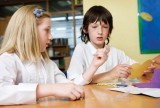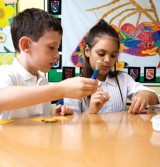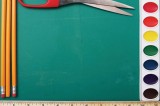Primary schools should strive to make goodquality crosscurricular links whilst maintaining the distinctive nature of subjects such as D&T...
One of the main purposes of Sir Jim Rose’s proposals for a new primary curriculum in England was to encourage schools to make more cross-curricular links. Of course, these proposals will now not become statutory, with the current subject-based National Curriculum remaining in force until the end of July 2012. Thereafter, we expect a new, slimmed-down National Curriculum, most-likely based on a similar framework of subjects. So where does this leave the role of cross-curricular links, which many consider to be central to good primary practice?
Firstly, it’s important to be clear about the difference between the ‘what’ and the ‘how’ of the primary curriculum. Although the compulsory curriculum is specified through the programmes of study for each subject, how this content is organised and taught remains entirely a matter for schools, so there’s no reason for teachers to feel anxious about continuing to make links between subjects.
The best primary practice includes a blend of rigorous, discrete subject teaching and equally effective cross-curricular links – both approaches are needed for effective learning.
 It’s helpful to think about cross-curricular links in two ways. First, there are the links where children use and apply aspects of learning from one subject in another – e.g. the application of science understanding in D&T. Learning in both subjects can benefit. Not only will children have the opportunity to deepen their understanding of key science concepts, they’ll also be better equipped to make informed design decisions in D&T. For instance, children designing and making bags can use their science understanding of the properties of materials when selecting from a range of fabrics, thinking about who the bags are for and how they’ll be used. Of course, there are also opportunities with this project for children to make use of learning from a number of other subjects: maths, art and design and ICT to name but three.
It’s helpful to think about cross-curricular links in two ways. First, there are the links where children use and apply aspects of learning from one subject in another – e.g. the application of science understanding in D&T. Learning in both subjects can benefit. Not only will children have the opportunity to deepen their understanding of key science concepts, they’ll also be better equipped to make informed design decisions in D&T. For instance, children designing and making bags can use their science understanding of the properties of materials when selecting from a range of fabrics, thinking about who the bags are for and how they’ll be used. Of course, there are also opportunities with this project for children to make use of learning from a number of other subjects: maths, art and design and ICT to name but three.
The second type of link is where one subject provides a context for developing learning in another. This is useful because it helps engage children in their learning and provides a mechanism for teachers to adapt activities so that all children can make good progress. The important thing here is to know your class well, pinpointing contexts that groups of children and individuals find motivating, giving their learning a sense of purpose and direction. Children’s achievement in areas such as literacy and mathematics can be given a tremendous boost by looking across the curriculum for engaging contexts. This approach is supported by evidence from the Cambridge Primary Review which found that “far from being a threat to achieved standards in ‘the basics’, a broad, rich, balanced and well-managed curriculum is actually the prerequisite for those standards.”
As long as your curriculum is broad enough, it should be easy to find contexts for teaching literacy and maths which engage your whole class. If you have a group of children who are under-performing with their writing, try finding out which subjects (or aspects of subjects) they’re interested in and use these as the contexts for their literacy work.
In a D&T example, KS2 children were set the brief of designing and making electrical board games. During the same term children focused in literacy on writing explanations and learnt about the organisational structure and language features of this text type. To design their own board games, they explored and evaluated a range of existing games, considering how they worked, and how they were made and were played. By scheduling this activity first thing in the morning, the teacher was able to capitalise on children’s enthusiasm during the subsequent literacy session where they were able to use their ideas, understanding and technical vocabulary to write an explanation about one of the games. A particular favourite was the ‘Operation’ board game.
 There are boundless opportunities for embedding literacy and maths across the curriculum – try them out to see what works well and embed the most productive links into your curriculum planning. This can be time consuming, so it’s worthwhile to consult your local authority, subject associations and web-based resources to see whether planning models and advice are available to support you. E.g., to support the embedding of literacy across the curriculum, the Design and Technology Association has developed free ‘Creative Curriculum’ posters for KS1, early KS2 and late KS2 that link up literacy units with the relevant aspects of D&T – visit http://www.data.org.uk
There are boundless opportunities for embedding literacy and maths across the curriculum – try them out to see what works well and embed the most productive links into your curriculum planning. This can be time consuming, so it’s worthwhile to consult your local authority, subject associations and web-based resources to see whether planning models and advice are available to support you. E.g., to support the embedding of literacy across the curriculum, the Design and Technology Association has developed free ‘Creative Curriculum’ posters for KS1, early KS2 and late KS2 that link up literacy units with the relevant aspects of D&T – visit http://www.data.org.uk

• Cambridge Primary Review – http://www.primaryreview.org.uk
• See the Design and Technology Association website – http://www.data.org.uk – for free guidance and a PowerPoint on the essential ingredients of a D&T project. Contact executive officer Julie Lunt at julie.lunt @data.org.uk
• Example of a cross-curricular project on Teachers TV – http://www.teachers.tv/videos/greatprimary- lesson-ideas-making-bags
Assess your cross-curricular connections with these helpful check lists…
Check list 1: Making good links
• Does the link make learning more motivating ?
• Does the link deepen children’s understanding?
• Has the integrity of each subject been maintained?
• Is there a natural overlap between the subjects being linked?
• Are the links made explicit to children?
• Can children see why they are making the link?
• Does the link guarantee appropriate coverage and progression in the subjects involved?
• Does medium-term planning dovetail learning between the subjects effectively?
Check list 2: Maintaining integrity in D&T
• Does your D&T project include these elements?
• User – who the products are for
• Purpose – what tasks the products will perform
• Functionality – how the products will work
• Design Decisions – the opportunities children have to make choices
• Innovation – the scope children have to be original with their thinking
• Authenticity – how believable/credible the products will be to the children
The Design and Technology Association is the recognised subject association for D&T. Its aim is to inspire, develop and support excellence in design and technology education for all and it is committed to helping primary schools to achieve the highest possible standards in D&T in foundation stage, KS1 and KS2. For its primary members it is an excellent source of low-cost regular CPD through a range of services including downloadable ready-made teaching resources (including PowerPoints, worksheets, posters and helpsheets), termly specialist magazines featuring new units of work, conferences and events and individual phone and email advice. For further details visit http://www.data.org.uk, email info @data.org.uk, or call 01789 470007.
8 Ways To Get Your Class Drawing
Ace-Art-And-Design
5 Ways To Celebrate World Book Day
Ace-Classroom-Support
Help Pupils Tell Fact From Fiction In The Digital World
Ace-Computing
